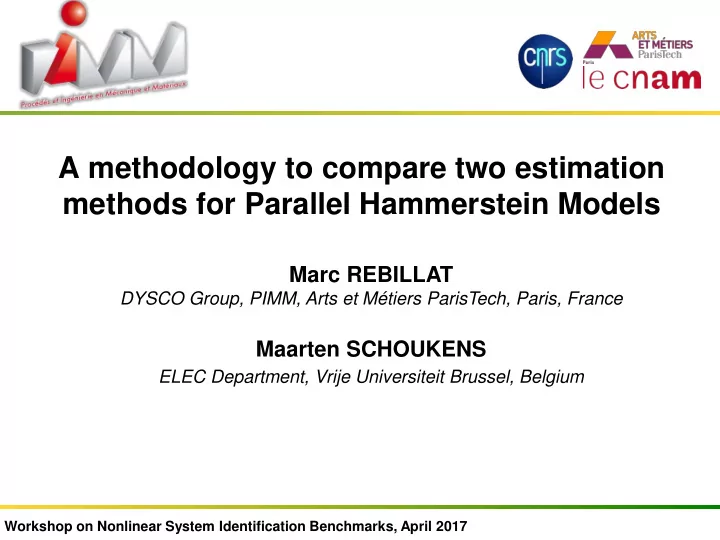

A methodology to compare two estimation methods for Parallel Hammerstein Models Marc REBILLAT DYSCO Group, PIMM, Arts et Métiers ParisTech, Paris, France Maarten SCHOUKENS ELEC Department, Vrije Universiteit Brussel, Belgium Workshop on Nonlinear System Identification Benchmarks, April 2017
Introduction Parallel Hammerstein Models (PHMs) Subclass of Volterra series: relatively general (to discuss) Represented by N linear filters: rather simple Workshop on Nonlinear System Identification Benchmarks, April 2017 2
Introduction Objective Various methods are available to estimate PHMs: ➢ LS: Least-square based methods ➢ ESS : Exponential sine sweep based methods ➢ … How can we fairly compare them? Workshop on Nonlinear System Identification Benchmarks, April 2017 3
I) LS method A problem that is linear in the parameters… Output of a Parallel Hammerstein Model: 𝑂 𝑜 ℎ ℎ 𝑜 𝜐 𝑣 𝑜 (𝑢 − 𝜐) 𝑧 𝑢 = 𝑜=1 𝜐=0 𝑧 = 𝐿𝜄 An alternative way to write it: ➢ 𝑧 : Vector of output samples ➢ 𝐿 : Regressor matrix [input dependent] ➢ 𝜄 : Parameters to estimate [kernels ℎ 𝑜 (𝑢) ] 𝜄 = 𝐿 𝑈 𝐿 −1 𝐿 𝑈 𝑧 A least square solution: Workshop on Nonlinear System Identification Benchmarks, April 2017 4
I) LS method Incorporating priori knowledge through regularization What is known: ➢ The system is exponentially decaying ( stability ) ➢ Impulse responses samples are highly correlated ( smoothness ) A regularized cost function: 𝑧 − 𝐿𝜄 2 + 𝜄 𝑈 𝑆𝜄 𝑊 𝑠 = ➢ 𝑆 : Regularization matrix implemented as a block- diagonal matrix using the TC-kernel (Pillonetto, 2014) Workshop on Nonlinear System Identification Benchmarks, April 2017 5
I) LS method Overview Least-square 𝑧 = 𝐿𝜄 Regularization estimation Direct Least-Squares (DLS): ➢ Input signal: Arbitrary (White Gaussian Noise [WGN] preferred) ➢ Parameters: FIR length, nonlinear order. Regularized Least-Squares (RLS): ➢ Input signal: Arbitrary (WGN preferred) ➢ Parameters: FIR length, nonlinear order, 2 regularization hyperparameters. Workshop on Nonlinear System Identification Benchmarks, April 2017 6
II) ESS method Effect of the inverse filter on the output signal Output s(t) = ∗ Inverse filter y(t) Temporal alignment of the harmonics energy Workshop on Nonlinear System Identification Benchmarks, April 2017 7
II) ESS method Temporal Windowing g n (t) : contributions of the different harmonics Workshop on Nonlinear System Identification Benchmarks, April 2017 8
II) ESS method From harmonics to power… h 2 (t): contribution of the g 2 (t): contribution of the 2 nd harmonic power 2 cos 2 𝑦 = 1 2 [1 + cos 2𝑦 ] Linear relation ship between ℎ 𝑙 (𝑢) and 𝑜 (𝑢) : ℎ 1 𝑢 1 𝑢 ⋮ = 𝐵 ⋮ ℎ 𝑂 (𝑢) 𝑂 (𝑢) All the filters 𝒊 𝒍 (𝒖) are estimated. Workshop on Nonlinear System Identification Benchmarks, April 2017 9
I) LS method Overview Inverse Temporal ℎ = 𝐵 convolution windowing Exponential sine sweep method (ESS): ➢ Input signal: Exponential sine sweep (ESS) ➢ Parameters: Nonlinear order. Non-parametric exponential sine sweep method (NP-ESS): ➢ Input signal: ESS ➢ Parameters: none. Workshop on Nonlinear System Identification Benchmarks, April 2017 10
III) Comparison methodology Performance indexes What you pay: ➢ Computation time ➢ Parameters assignment What you end up with: ➢ 𝑄𝐽 1 : Ability to reconstruct the output from an ESS ➢ 𝑄𝐽 2 : Ability to reconstruct the output from a WGN ➢ 𝑄𝐽 3 : Ability to estimate the Kernels: 𝑂 2 𝐿 σ 𝑙=0 𝑄𝐽 3 = 1 ℎ 𝑜 𝑢 − ℎ 𝑜 𝑢 𝑂 𝐿 σ 𝑙=0 [ℎ 𝑜 𝑢 ] 2 𝑜=1 Workshop on Nonlinear System Identification Benchmarks, April 2017 11
III) Comparison methodology Experimental plan Workshop on Nonlinear System Identification Benchmarks, April 2017 12
IV) Application: system #1 PHM of order 𝑂 = 4 Workshop on Nonlinear System Identification Benchmarks, April 2017 13
IV) Application: system #1 𝑄𝐽 1 : Ability to reconstruct the output of an ESS ESS methods are computationally very efficient LS methods are very precise Workshop on Nonlinear System Identification Benchmarks, April 2017 14
IV) Application: system #1 𝑄𝐽 2 : Ability to reconstruct the output of a WGN ESS methods can reconstruct WGN output LS methods can be very precise Workshop on Nonlinear System Identification Benchmarks, April 2017 15
IV) Application: system #1 𝑄𝐽 3 : Ability to estimate the Kernels NP-ESS methods needs long enough signals RLS methods more precise than DLS (specially with WGN) Workshop on Nonlinear System Identification Benchmarks, April 2017 16
IV) Application: system #2 [Bouc-Wen] 𝑄𝐽 1 : Ability to reconstruct the output of an ESS Large computational gap for equal performances Large influence of input signal for LS methods Workshop on Nonlinear System Identification Benchmarks, April 2017 17
IV) Application: system #2 𝑄𝐽 2 : Ability to reconstruct the output of a WGN Large computational gap for almost equal performances Large influence of input signal for LS methods Workshop on Nonlinear System Identification Benchmarks, April 2017 18
Conclusion Overview ESS methods: ➢ Computationally very efficient ➢ Non parametric (or almost) ➢ Not extremely precise LS methods: ➢ Computationally more intensive ➢ Can be extremely precise ➢ Parameters to be set ESS methods could guide LS methods? Workshop on Nonlinear System Identification Benchmarks, April 2017 19
Conclusion But … Performances of the Exponential Sine Sweep Method ➢ Managing and quantifying uncertainties… ➢ Extension to Parallel Wiener Models… ➢ Theoretical understanding of the estimator properties… ➢ Lower assumptions on input signal… Workshop on Nonlinear System Identification Benchmarks, April 2017 20
Questions? A methodology to compare two estimation methods for Parallel Hammerstein Models Marc REBILLAT DYSCO Group, PIMM, Arts et Métiers ParisTech, Paris, France Maarten SCHOUKENS ELEC Department, Vrije Universiteit Brussel, Belgium Workshop on Nonlinear System Identification Benchmarks, April 2017
Recommend
More recommend